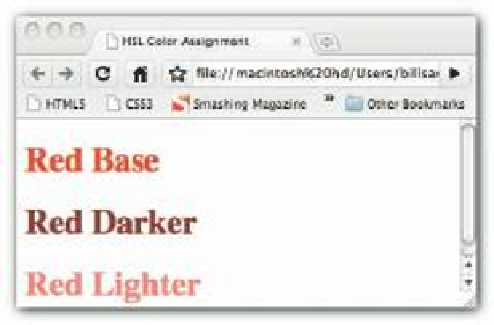HTML and CSS Reference
In-Depth Information
<
style type
=
”text/css”
>
.
redBase
{
color
:
hsl
(
0
,
100
%,
50
%);
}
.
redDarker
{
color
:
hsl
(
0
,
100
%,
25
%);
}
.
redLighter
{
color
:
hsl
(
0
,
100
%,
75
%);
}
</
style
>
<
meta http
-
equiv
=
”Content-Type”
content
=
”text/html; charset=UTF-8”
>
<
title
>
HSL Color Assignment
</
title
>
</
head
>
<
body
>
<
h1 class
=
”redBase”
>
Red Base
</
h1
>
<
h1 class
=
”redDarker”
>
Red Darker
</
h1
>
<
h1 class
=
”redLighter”
>
Red Lighter
</
h1
>
</
body
>
</
html
>
When i rst using HSL, it helps to think of adding light by going higher to the sun or making it
darker by going lower into a well. h e tweaking process is easier for designers to get just what
they want. Figure 4-3 shows what the dif erent red tints look like.
69
Figure 4-3: HSL makes tweaking tints easy.
Hue and light are fairly intuitive to understand, but saturation can be a little murky. Essen-
tially, saturation is the amount of colorfulness in a given color. A 100 percent saturation is the
full colorfulness of a hue in a given light, while a lower percent subtracts from a hue — some-
thing like a color fading. For all colors, a midpoint light is going to be gray when saturation is
0 percent. Sometimes a faded or muted color is preferred, like blue jeans that have been
washed many times.

























